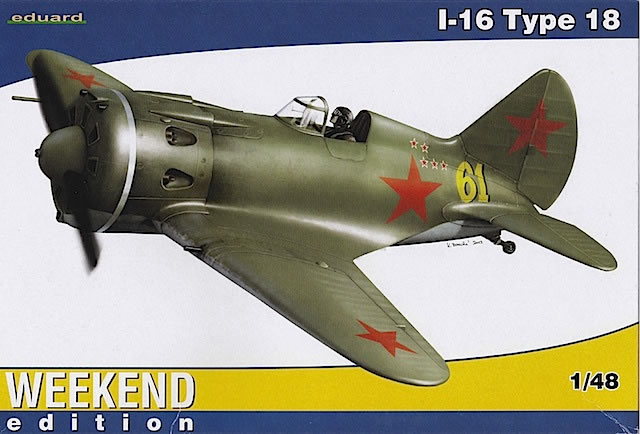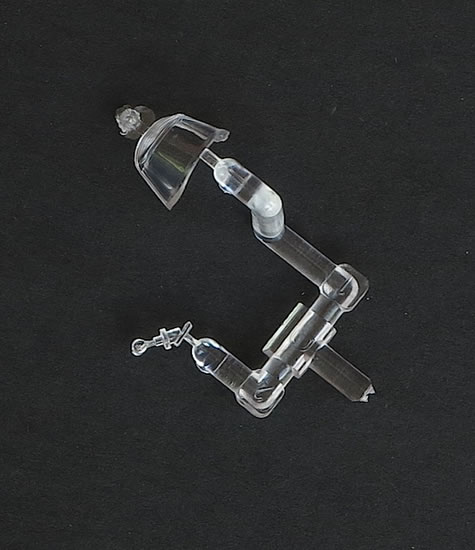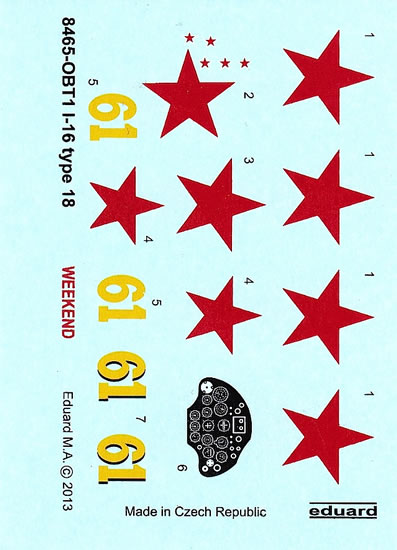|
I-16 Type 18 Weekend Edition
Weekend Edition

Eduard, 1/48 scale
S u m m a r y : |
Catalogue Number: |
Eduard Kit No.8465 - I-16 Type 18 Weekend Edition |
Scale: |
1/48 |
Contents & Media: |
Approximately 92 grey plastic parts (11 unused); 2 clear plastic parts; 1 decal sheet containing markings for 1 aircraft; 8 page black and white instruction booklet. |
Price: |
USD$16.96 plus shipping available online from Eduard’s website |
Review Type: |
First Look |
Advantages: |
Sound basic kit |
Disadvantages: |
The kit as supplied represents an I-16 Type 24, but the changes required to produce a Type 18 are very minor |
Conclusions: |
Highly recommended to WW2 Soviet aviation modelers, or anyone wanting a quick and simple build to chase away the modeling blues.. |
Reviewed by
Brad Fallen

Eduard's 1/48 scale I-16 Type 18 Weekend Edition is available online from Squadron.com
The Polikarpov I-16 Type 18 entered production in 1939 and offered a number of improvements over the preceding major production model, the Type 10. These included a more powerful engine, with the 800 hp Shvetsov M-62 replacing the Type 10’s 750 hp M-25 engine. The M-62 was nearly 50 kg heavier than the M-25, but still boosted performance enough to be a worthwhile upgrade. The new engine precipitated a number of other revisions, including to the cowling, spinner and propeller.
Late production Type 18s were equipped with tail wheels (as opposed to the skid fitted to the Type 10 and earlier versions) and an additional starboard cockpit door. It appears that slightly fewer than 200 Type 18s were built, compared to nearly 1,000 each of the Type 10 and subsequent Type 24 versions.
Eduard produced its first 1/48 I-16 kit back in 2006 and has since released kits of the following variants, in some cases more than once:
Eduard has now added a Type 18 to the range. This version was previously only available in the comparatively expensive, and long out of production, 2006 Royal Class boxing, so its recent release in Weekend Edition format is most welcome.
A 1/48 I-16 model is quite small – 19cm wide by 12.5cm long – and so the kit box is also fairly compact. Inside are one clear and five grey plastic sprues, along with a small decal sheet and an eight page black and white instruction booklet.
Consistent with the findings of previous Eduard I-16 reviews here on Hyperscale, the Type 18 plastic parts are cleanly moulded with well-defined panel lines, appropriate raised detail and a restrained interpretation of fabric covering. Detail on the smaller parts is subtle, with the individual, partially hollowed out exhaust stacks particularly good. The two clear parts – the windscreen and gunsight – are packaged separately to avoid damage, and look good.

As a Weekend Edition boxing the kit contains only one marking option, for ‘Yellow 61’ of the 286th IAP operating in the Leningrad sector in spring 1942, and no photo-etched detailing parts. The absence of the latter doesn’t matter much because the cockpit has some good plastic detail, and the instrument panel is taken care of with a decal. I would however add some aftermarket or scratch-built seat belts: the open cockpit will look bare without them.
I wanted to see how Eduard had tackled the Type 18 compared to the Type 24, so put the sprues of this kit next to those of the Type 24 Weekend Edition I reviewed earlier this year. To my surprise, they are identical – and while the sprues contain a number of optional parts, these are mostly aimed at earlier I-16 variants, and not the more subtle differences between the Type 18 and Type 24. The instructions do make clear that the gun camera-mounting bracket fitted to the fuselage spine of the Type 24 is not required on the Type 18, but don’t mention that the radio access hatch on the starboard rear fuselage is also not appropriate for the earlier version. Fortunately the hatch is represented by raised detail, which (with care) should be reasonably straightforward to remove.
The instructions would also have you fit a tailwheel, which combined with the kit’s Type 24-style starboard cockpit access door will deliver a late production Type 18 model. Again however, as with removing the radio access hatch, there are easy fixes if you want to model an aircraft from earlier in the production run: substitute the tailskid (part E20) for the tailwheel, and fill the recessed panel line that represents the starboard cockpit door.
The engine (part F7) is represented by a half-bank of cylinders and is generic to all Eduard I-16 kits; there is no attempt to differentiate between the Type 10’s M-25 engine, the Type 18’s M-62, or the Type 24’s M-63. Very little of the engine is visible behind the cowling, however, so this is an acceptable compromise.
My range of I-16 references is reasonably limited, so there may be further differences between the Type 18 and Type 24 that I have missed. Based on the material I have to hand, though, I think an acceptable Type 18 model can be built from this kit – you just need to be aware that what’s in the box isn’t exactly what’s on the label, and prepared to do some minor modifications.
Markings
As is often the case with Weekend Edition kits, the marking option has been drawn from a previous Eduard kit of the subject – in this case the 2006 Royal Class boxing, where ‘Yellow 61’ was one of the two Type 18s represented. I haven’t been able to discover anything about this aircraft beyond what’s in the instructions, and so would be grateful if anyone could point me in the direction of further information. The painting and marking guide indicates that ‘Yellow 61’ was painted in green over light blue, for which Eduard recommends Gunze Sanyo Mr. Color 136 Russian Green 2 and Mr. Color 74 Air Superiority Blue as appropriate equivalents.

The small decal sheet contains only 13 decals, of which more than half are red stars for the wings, vertical tail and fuselage sides. Two versions of ‘Yellow 61’ are provided, one with black shadowing and one without, allowing modelers to select the option they see as most appropriate. The decals have been manufactured by Eduard and look very well produced, with crisp printing and limited carrier film.
Although produced in comparatively limited numbers the Type 18 was an important step in I-16 design evolution, and Eduard’s release of the version as a standalone kit is therefore welcome. Even though the kit itself represents a Type 24, the minor changes required to convert it to a Type 18 should be within the ability of most modelers. Highly recommended to WW2 Soviet aviation modelers, and anyone wanting a quick and simple build to chase away the modeling blues.
Highly recommended.
References
Hans-Heiri Stapfer, Polikarpov Fighters in action Part 2 (Squadron/Signal Publications, 1996).
Modeling the Aircraft of the Soviet VVS 1917-1950, www.vvs.hobbyvista.com
Thanks to Eduard for the sample and for the images.
Review Text Copyright © 2013 by Brad Fallen
Page Created 9 December, 2013
Last updated
9 December, 2013
Back to HyperScale Main Page
Back to Reviews Page

|
